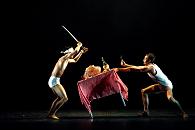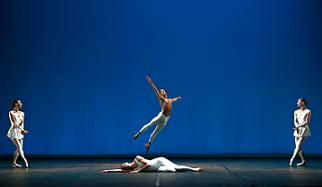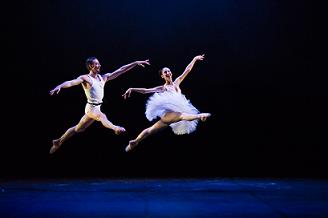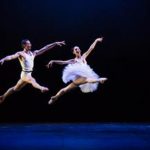Illustrious deceased and living artists. Moving tributes and joyful parodies. At the heart, the creative and fulfilling love of dance, with Eric Vu-An on stage. Sometimes as a choreographic demiurge using Paganini’s notes as invisible threads that precisely manipulate the movements of his dancers. Sometimes as a grateful former apprentice honoring the pivotal encounter with his spiritual master, Maurice Béjart. For the second evening of the season, the Artistic Director of Ballet Nice Méditerranée presented us with an extraordinary show. On the program, a choreographic triptych dedicated to Niccolo Paganini, Maurice Béjart, and Guiseppe Verdi, respectively.
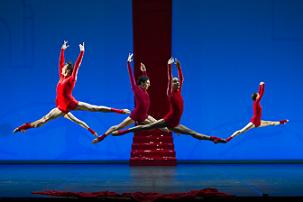
After the Faustian pact, redemption. In “Cantate 51,” a work of his spiritual master Maurice Béjart created in December 1969 in Brussels, the music of Johann Sebastian Bach develops themes of praise, glory, and resurrection. Surrounded by two angels of indescribable grace (Julia Bailet and Sophie Benoit), the Archangel Gabriel and the Virgin Mary (César Rubio Sancho and Céline Marcinno) rise in a duo of particularly demanding spirituality. Eric Vu-An’s homage to his late master and protector is sincere and vibrant. However, the intensity of this emotional charge weighed on the dancers, moved to the point of trembling in their stage attitudes and sometimes destabilized in their lifts.
After the effort, the comfort. However, this was not entirely restful for the artists. Contrary to appearances, the choreographic parody on Italy elaborated by Luciano Cannito requires a superior mastery of the scenic art to dare a “joyful distance.” “Viva Verdi” thus offers a potpourri of Italian cultural clichés skillfully if not subtly staged by this Neapolitan who already has forty-five ballets and three musicals to his credit. The classical pas de deux derails along the way to turn into a Saturday Night Fever, masterfully performed by the soloist Jean-Sébastien Colau. He conspicuously combines fulfilled love for dance and passion for Commedia dell’arte. His duets with Veronica Colombo, where both dancers, their faces radiant with joy, convey their happiness to the audience, will remain, beyond the playful episodes of the show, a highlight of this third part.
Obviously, the work started barely a few months ago by Eric Vu-An is already bearing fruit. Considering the bold creations announced by the Artistic Director of the Ballet during the presentation of the 2010-2011 Season (“Marco Polo” by the same Luciano Cannito, “Don Quixote,” “En Sol” set to music by Maurice Ravel in a choreography by Jérôme Robbins, “Creation” by Lucinda Childs, “The Envelope” by David Parsons—the choreographer of West Side Story—and “Sylvia” set to music by Leo Delibes), the audience is surely not at the end of their divine surprises.
Photos: Dominique Jaussein
